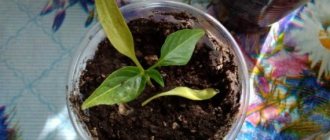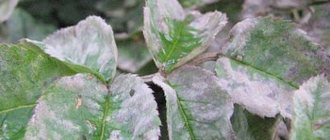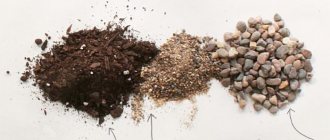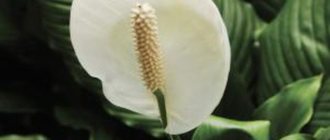Why did the spathiphyllum leaves droop?
The reason why the spathiphyllum leaves droop is determined by examining the plant. The solution to the problem depends on the situation.
There are several most common reasons:
- unsuccessful transplantation - unsuitable soil and lack of drainage layer;
- drying out of the soil or excessive watering;
- negative changes in the root system;
- sudden changes in conditions of detention.
Let's look at each reason in more detail and try to find a solution to the problem.
What to do to resuscitate a flower?
When the first painful signs appear, the plant needs attention and the elimination of factors that provoke the death of the plant. Each problem has its own causes and requires a specific approach. First of all, it is necessary to determine what provokes this state of plants, and then move on to resuscitation of the flower.
Dropped the leaves
In case of insufficient watering and dry air, the following measures are necessary::
- Place the flower pot in a container of water for 15-20 minutes. During this time, the soil will be saturated with moisture, and the roots will begin to receive the missing substances.
- Spray spathiphyllum 2 times a day with purified, warm water.
- Make sure there is sufficient air humidity - use a household humidifier, you can also place a pot next to the aquarium.
When water stagnates, the plant needs:
- Remove from the pot and inspect the roots. All dry, lifeless and dark brown roots are cut off, disinfecting the cut areas. The root system is dried.
- Place the plant in new, dry soil. Do not water immediately.
- Analyze the watering of the flower and normalize the frequency of watering.
Blackened
In dry air it is necessary:
- Consider additional air humidification measures. Install a humidifier.
- Place the pot with spathiphyllum in a container with damp drainage.
- Organize daily spraying.
Withers
Is it possible to rehabilitate a flower if it has withered? Spathiphyllum can be brought back to life during the period of wilting. If the plant withers, restore it as follows:
- After watering, check the soil to see how wet it is, paying attention to its structure.
- If moisture does not pass through well, the plant is removed from the pot. Free the roots from peat.
- Spathiphyllum is transplanted into light, homogeneous soil. In this case, it is necessary to make a drainage layer of 2 cm.
We invite you to watch a video about resuscitating a plant when its leaves wilt:
Turned yellow
If a flower begins to show yellowness it needs:
- Review lighting. If the rays are too bright, you need to slightly shade the window with the flower with curtains.
- Normalize the irrigation system.
- Provide optimal humidity.
- Review the condition of the soil and replace it with a new one if necessary.
We invite you to watch a video about measures to prevent yellowing of spathiphyllum leaves:
Transplantation: soil, choice of flower pot
Spathiphyllum leaves could begin to wither due to incorrectly chosen timing of transplantation. This operation is recommended to be carried out in early spring before flowering begins, or 2 weeks after it ends. Without inflorescences, the plant recovers faster.
The soil in an adult species is renewed every 3-4 years, in a young plant up to three years old - every year. If you do this more often, the foliage will begin to wilt.
The new soil should be dry, properly fertilized, and loose. Heavy acidic soil negatively affects the life of the flower.
A prerequisite is the presence of a drainage layer of pebbles or expanded clay at least 2 cm thick. It is needed to prevent water from stagnating in the lower part of the container. For the same purpose, medium-sized holes are made at the bottom of the flowerpot.
The incorrect composition of the soil mixture is replaced with a ready-made peat substrate. But it dries out quickly, and water does not reach the roots. In this case, the flower is removed from the pot and the roots are cleared of the peat layer. After three hours, the flower is transplanted.
The pot for transplanting spathiphyllum should be cramped, since the root system of this species is short and there is no stem.
Symptom No. 3. Spathiphyllum turns yellow
Spathiphyllum leaves often turn yellow, massively. This greatly spoils the decorative appearance of the flower. Let's try to understand each specific situation.
We suggest you familiarize yourself with Condensation under the refrigerator
Spathiphyllum respects the so-called penumbra. That is, a large amount of diffused light, without direct sunlight. If you place a pot of spathiphyllum, say, on a southern or southwestern window sill, you will soon see that its leaves have lost their rich green color and have faded. Discolored leaves turn yellow and even turn white.
https://www.youtube.com/watch?v=ytcopyright
If the sun's rays were not only bright, but also hot, sunburn is possible. In this case, yellowing occurs in spots or stripes. Moreover, the burned parts become thinner, similar to parchment.
On southern windows, spathiphyllum leaves turn yellow or white from high light intensity
What to do?
If your spathiphyllum has turned yellow from excessive light, it must be moved to a darker place, without direct sunlight. Window sills of northern, northeastern, northwestern, eastern orientation are suitable for spathiphyllum. If all the windows in your apartment are sunny, it’s not scary. Place the spathiphyllum at some distance from the window, in the back of the room, to reduce the light intensity.
When spathiphyllum starves, the leaves turn yellow unevenly. For example, a “mosaic” color appears, that is, green spots remain on a yellow background or vice versa. The veins become discolored or, conversely, the veins remain green, and the leaf blade turns yellow. Yellowing of leaves against the background of green veins is a manifestation of iron chlorosis. All other uneven yellowing may be associated with a lack of a variety of microelements, in particular boron and calcium.
Lack of iron and other trace elements affects spathiphyllum leaves. They turn yellow and acquire a heterogeneous color
What to do?
Yellowing of spathiphyllum due to starvation can be easily eliminated by fertilizing and enriching the soil. You need to do the following:
- Transplant the spathiphyllum into new, light, loose soil. The soil reaction is slightly acidic.
- Spray the plant with iron chelate - if iron chlorosis is diagnosed, or with a complex fertilizer containing microelements (boron, calcium, iron) - if there is a general lack of nutrients.
- 2-3 weeks after transplantation, feed the spathiphyllum with complex fertilizer.
- All this time, water the plant with well-settled or boiled warm water, spray with water 2 times a day.
If the lower old leaves of spathiphyllum turn yellow, then this is a natural process that does not require any intervention. Old leaves die and new ones come to replace them. Yellowing can only be considered a problem if the process affects young leaves.
Watering: excess or lack of moisture
This type of plant needs frequent watering. The soil must remain moist at all times. At the same time, flooding the flower leads to rotting of the roots. They stop absorbing moisture and the plant does not receive nutrients. The leaves droop and quickly die. This is because rotting combined with low temperatures leads to infectious diseases. Eliminate excess moisture using absorbent paper napkins. They are placed on the ground, on leaves and under the pot. The procedure continues until the paper is dry.
The life of the plant is negatively affected by a prolonged lack of moisture. Lack of nutrients causes spathiphyllum leaves to quickly wither.
This, in particular, happens in the presence of an upper peat layer. For these soils, submersible irrigation technology is used for 10–20 minutes. It ensures the distribution of liquid throughout the soil.
A well-thought-out irrigation system can eliminate soil drying out. On the first day, it will be enough to use half the standard volume of water, after which the plant is covered with a transparent bag. After two days, the procedure is repeated. These measures help restore the root system and prevent severe wilting.
In a neglected situation, the roots and leaves of the flower are soaked in water for a quarter of an hour.
How should you care for a newly transplanted plant?
Spathiphyllum transplantation is difficult. In order for the plant to return to normal in a short time, it needs to provide the following conditions:
- Air humidity 50-70% - in nature, spathiphyllum is found in the humid environment of swampy forests of the United States and East Asia. You can create such a climate at home by spraying with a spray bottle or using a humidifier.
- Watering . The roots of the flower constantly need moist soil; you need to water the soil daily or every other day, at least.
- Lighting . The plant loves sunlight and bright rooms, but does not tolerate scorching sun well.
Problems with roots
In 90% of cases, spathiphyllum dies due to negative changes in the root system. To determine the condition of the plant, you need to pull its foliage. If the flower was easily pulled out, it will be impossible to save it.
If a problem arises with the roots, you cannot do without replanting. Before surgery, they are placed in a container with warm water for several hours or overnight. Then the rotten areas are inspected and removed with a sharp knife down to living tissue.
To disinfect sections, use ash, cinnamon, crushed activated carbon or sulfur powder. If necessary, treat the area with a weak solution of fungicide. An activated carbon tablet is also added to the new soil.
After transplantation, the flower is not watered. After three days, they begin to use root formation stimulants: Zircon, Kornevin or Epin.
During the first two months, the plant can be watered with a weak solution of nitrogen fertilizers. In this case, you should act carefully, since if there is an excess of such fertilizers, it dries faster.
Incorrect conditions of detention
The cause of the development of the disease may be improper plant maintenance conditions. Spathiphyllum loves the sun, but not scorching rays. As a permanent place of residence, it is best to choose window sills on the east or west side.
Low humidity levels can also cause illness. If the plant is very wilted, use a household humidifier or regularly spray it with warm water.
After transplantation, the flower is placed in greenhouse conditions for several weeks. To do this, organize a mini-greenhouse or cover it with a plastic bag.
The greenhouse maintains optimal temperature (+23. +25°C) and humidity level (50–70%). Ventilation and regular watering are provided.
Prevention
In order for the plant to quickly come to its senses after transplantation, it is necessary to create optimal conditions for it:
- place the flowerpot with a flower in a shaded place;
- provide sufficient humidity;
- Do not over-moisten the soil by watering and do not spray the plant for the first week.
When the first signs of poor condition of the spathiphyllum appear after transplantation, it needs to be provided with proper care. Prompt assistance and elimination of the source of trouble will help the plant not to die and recover in a short time.
If you find an error, please select a piece of text and press Ctrl+Enter.
The plant is withering, the leaves are turning yellow - what can be done?
Many gardeners complain that after transplantation, their tropical pet begins to wither, drop leaves, and turn yellow. Most often this occurs due to lack of moisture. Spray the plant more often (up to several times a day).
You need to water the flower carefully: an excessive amount of moisture in the soil can harm the root system, which will again lead to wilting of the leaves. Water the spathiphyllum generously, but only when the soil surface dries out.
The cause of wilting may be too much sunlight. Spathiphyllum loves diffused light, and even more - shade. If you decide to keep the plant on the windowsill, give preference to windows facing north, west and east.
Incorrect plant replanting
Poor quality or unsuitable soil, or a flowerpot of the wrong size, can cause the “female happiness” to begin to turn yellow after transplantation. The soil should be air- and water-permeable, and a layer of drainage should be placed underneath it.
The pot is chosen commensurate with the size of the flower. If after transplanting you are not sure whether the soil is suitable, water it and see how it absorbs moisture. If it’s bad, change the soil to looser, lighter soil with minerals. After changing the pot, do not overwater the flower. It’s better to treat it with Zircon.
Why does the flower of “female happiness” wither?
If the leaves of the spathiphyllum have begun to wither, there is no point in postponing measures to combat this disease. Wilting is a disease that appears as different parts of the flower drooping. The plant loses turgor (elasticity) and the natural color of leaf plates and stems.
In addition, in its advanced form, wilting can also provoke the appearance of spots on the leaves and the formation of mold on the top layer of soil. To help spathiphyllum quickly cope with such a disease, it is necessary to analyze both the conditions of keeping it indoors and the quality of care for it.
Adaptation after transplant
It often happens that after transplantation, the leaves of an exotic flower droop and they lose their bright green color. In most cases, such troubles resolve themselves when the spathiphyllum gets used to both the new soil substrate and the spacious pot.
Many gardeners are confident that frequent replacement of soil and containers has a beneficial effect on the growth and development of the green pet. But there are several nuances that should be taken into account for its successful cultivation:
- replanting is not recommended during the flowering period;
- the optimal frequency of such procedures for adult specimens is once every 3-4 years;
- You need to use only disinfected and fertile soil mixture with sufficient moisture and air permeability;
- The plant should be kept under a sealed cap (in a mini-greenhouse) for two weeks;
- The transplanted flower should not be placed in a sunny place (there is a risk of burns on the leaves).
To prevent spathiphyllum from drooping its leaves after transplantation and quickly adapt to new conditions, it is necessary to keep it in partial shade for the first 14 days after the manipulation, ventilate it daily, and spray it. It is recommended to open the mini-greenhouse for 5-10 minutes, and irrigate the top layer of soil using a spray bottle.
For these purposes, use alternately ordinary settled water and a solution of Kornevin, diluted according to the manufacturer’s instructions.
The soil is not suitable
If the leaves have drooped, the plant looks sick; the cause should also be looked for in the soil substrate. Spathiphyllum cannot be placed in a pot with heavy, poorly drained and acidic soil. As a result, the ornamental crop begins to rapidly wither, become sick and, in the absence of appropriate treatment, often dies.
The absence of a drainage cushion in the flowerpot has a negative effect on the condition of the green pet.
Expanded clay balls, pebbles, and broken bricks are used as suitable materials.
The transport soil in which spathiphyllum is sold is also not suitable for growing at home. Its main component is peat; it quickly becomes moisturized in the upper layers, but inside it turns out to be dry, which is why the roots of the plant are left without moisture.
First aid and preventive measures
There are several recommendations to revive the “female happiness” flower:
- Place the plant in a well-lit area with bright but diffused light. If necessary, the flower should be darkened from direct sunlight. Lack of lighting should not be allowed.
- If the earthen clod dries out completely, you should not water it frequently; it is better to immediately place the pot with the plant in a container of water.
- When replanting, do not forget to place a layer of drainage on the bottom of the flowerpot.
- Monitor the condition of the flower's root system.
- Do not overdry or over-moisten the soil substrate; watering should be moderate.
- If the spathiphyllum has been affected by a fungal or viral disease, then the soil must be replaced.
- By maintaining optimal temperature and humidity levels in the room, you reduce the likelihood of the flower being damaged by diseases and pests.
- It is recommended to add nitrogen-containing fertilizer to water for irrigation.
By figuring out what to do when spathiphyllum withers, you will quickly help it recover. The main thing is not to delay treatment and use agrochemicals strictly in accordance with the instructions. For planting work, the soil must be disinfected in order to destroy the pathogenic microflora in it. Only an integrated approach will allow you to avoid problems when growing such an original flower as “women’s happiness.”











